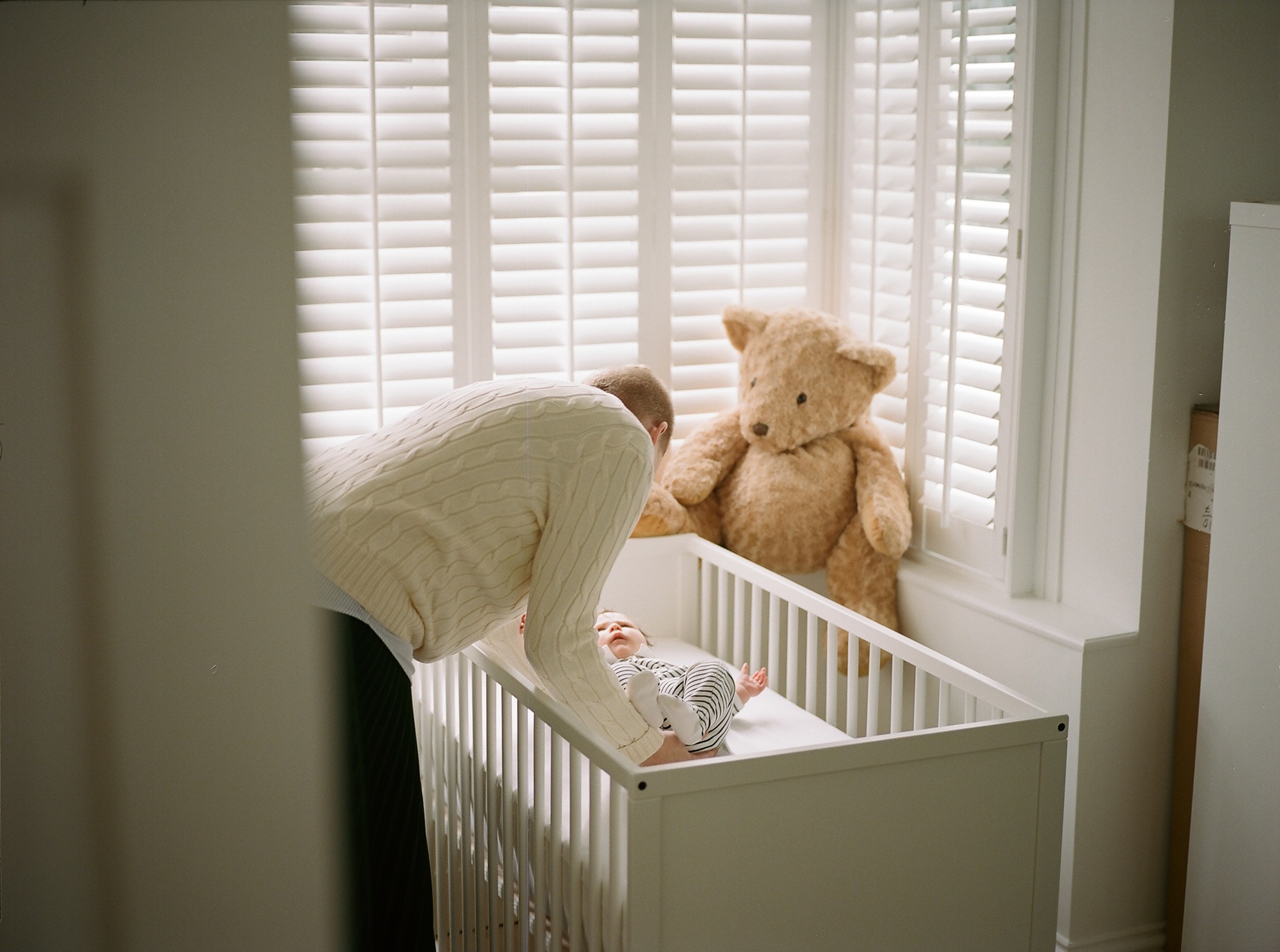
GET STARTED WITH A FREE CUSTOM SCHEDULE AND PLAN OVERVIEW ON OUR MOBILE APP →
TRY BATELLE FOR FREE →

In 2022, Nanit published their internal sleep study, “Implementation of Behavioral Interventions for Infant Sleep Problems in Real-World Settings.” Research titles can be a bit overwhelming at times, so to clarify, Nanit conducted a child sleep training study.
As experts in pediatric sleep intervention, Batelle values Nanit’s research and analysis, and we want to help break down and share as much of the relevant data as possible. The original research publication can be accessed through The Journal of Pediatrics; however, for those who hesitate to purchase a subscription to read through its 30+ pages, we have provided a summary and analysis below.
This research study is so important because it’s one of the largest pediatric sleep studies to date, supported by technology-derived, objective infant sleep data. But that’s also the limitation of the study…
Nanit focused so heavily on objective sleep data and child behavior to make conclusions about sleep interventions that they neglected the most critical component of sleep training – parental behavior.
Nanit concluded that infants who were sleep trained using the Unmodified Extinction Method (cry-it-out) and/or the Modified Extinction Method (modified cry-it-out) displayed greater sleep consolidation, less frequent night wakes, and faster overall sleep improvement than those who used Parental Presence. Unmodified Extinction was considered to be the most helpful method, Modified Extinction was rated next, and Parental Presence was rated as the least helpful method.
The study was uncontrolled, parent intervention varied in consistency and method, and none of the parental interventions were monitored for efficacy. Data was also concluded using out-dated sleep training experiences (up to 12 months prior to the sleep survey), leading to a deviation in recall, otherwise known as retrospection bias.
Batelle seeks to produce data that is accurate, informative, and relevant to the how of pediatric sleep intervention because we know that the how is one of the greatest catalysts in improving children’s sleep. While Batelle has yet to publish an official sleep study (this is in the works!), we have supported, monitored, and gathered real-time experiential data from over 2,500 families during their sleep training experience.
Our company can offer money-backed guaranteed sleep training results because of the interactive and supportive design of our Sleep School program. Our method of parental engagement and sleep intervention has been closely monitored, appropriately adapted, and implemented in real-world environments providing us with mass evidence of our method’s efficacy.
So while Nanit’s research provides us with further insights into pediatric sleep, bear in mind that it does not account for any parental engagement necessary to gauge the efficacy of specific sleep interventions. As a company specializing in infant sleep training, Batelle endeavors to soon produce research of our own, focusing specifically on parental behavior. After all, you as the parent are the key to establishing good sleep habits in your child.
In September 2021, Nanit conducted an infant sleep study to assess the implementation and efficacy of behavioral sleep interventions (BSI) in real-world settings. To conduct the study, Nanit invited all Nanit Pro Baby Camera users who had previously consented to research data collection to participate in the sleep study in exchange for a raffle entry.
Nanit received responses from 3,069 families; however, only 2,090 children were eligible to participate in the study.
The metrics Nanit used to measure sleep consisted of night sleep duration (total minutes), number of night wakes (minimum 3min wake duration), and number of parent crib visits. After collecting the two weeks of technology-recorded sleep data from the children that met the requirements, Nanit had a total of 24,506 nights of sleep data to assess.
To gain further information regarding sleep and behavioral sleep interventions, Nanit also conducted a survey with families to understand their child’s sleep as well as their own parental sleep, their mental and emotional well-being, their daytime performance, their sleep training behaviors, and their relationship with their child.
Based on the answers collected in the surveys, families were then categorized into four behavioral sleep intervention groups for research analysis:

Any family that reported implementing more than one behavioral sleep intervention method was categorized by the method that they used most recently.
According to the parent sleep survey data, the Unmodified Extinction Method (Cry-It-Out) and the Modified Extinction Method (Controlled Crying), “were rated as significantly more difficult to implement compared with Parental Presence,” but they were also considered to be “more helpful, shorter, and quicker to show improvements.” (Kahn M, Barnett N, Gradisar M).
The infants who were sleep trained using the Unmodified Extinction Method and/or the Modified Extinction Method also displayed greater sleep consolidation, less frequent night wakes, and faster overall sleep improvement. Unmodified Extinction was considered to be the most helpful method, Modified Extinction was rated next, and Parental Presence was rated as the least helpful method.
“Parents who had implemented Parental Presence were likely to perceive their infant’s current sleep as more problematic compared with parents who had implemented [the other methods]” (Kahn M, Barnett N, Gradisar M). The results of the study also “suggest that when implemented in real-world settings, Parental Presence may be less effective in improving infant sleep than Unmodified and Modified Extinction” (Kahn M, Barnett N, Gradisar M).
The study was uncontrolled, some of the data was incomplete, and the details of the sleep interventions were undefined, but this study opened the doors for real-world pediatric sleep research. Sleep is a very common, real-world problem, so it is vital that we prioritize more real-world studies and data to support the pediatric sleep industry.
Unfortunately, “15–25% of infants meet criteria for pediatric insomnia… [and it] tends to persist when untreated” (Kahn M, Barnett N, Gradisar M). Pediatric insomnia is an undeniable strain on both an infant and the family unit supporting them because sleep affects everything. Infantile sleep difficulties are closely linked to “adverse short-term and long-term… problems, including child physiological, emotional, cognitive, and behavioral difficulties, and poor parent health and wellbeing” (Kahn M, Barnett N, Gradisar M).
This study generated further evidence that behavioral sleep interventions are not only safe but also more effective than alternative methods. Despite this study’s construction, there are more than four sleep intervention types available to choose from when deciding the most supportive method for your child and your family.
Batelle’s method merges the closeness, responsiveness, and emotional support of Parent Presence with the structure and efficacy of Modified Behavioral Interventions to guarantee the best results for our families. Nanit’s research conclusions are sound, and sleep training is undoubtedly safe and supportive for a child, but we also know that Nanit’s technology cannot track a child’s internal experience.
Bedtime protests and nighttime cries are a child’s way of expressing the emotions they don’t have the words for. At Batelle, we encourage a responsive and communicative relationship between parents and their children. We want children to trust sleep, trust that their parents will be there in times of need, and develop genuine internal regulation skills. Because of these philosophies and because of various cognitive research, we cannot promote Cry-It-Out methods that encourage parents and children to disengage from one another. To better understand, watch the video message from a neuroscientist who went through our program.
All things considered, families should explore the approaches that align most with their parenting and life preferences, and if you are in search of something more holistic, something routed in attachment-parenting, and something that will foster strong developmental skills for your child, we encourage you to reach out.
Kahn M, Barnett N, Gradisar M, Implementation of Behavioral Interventions for Infant Sleep Problems in Real-world Settings, The Journal of Pediatrics (2022), doi: https:// doi.org/10.1016/j.jpeds.2022.10.038.
Schwichtenberg AJ, Choe J, Kellerman A, Abel EA, Delp EJ. Pediatric Videosomnography: Can Signal/Video Processing Distinguish Sleep and Wake States? Front Pediatr. 2018 Jun 19;6:158. doi: 10.3389/fped.2018.00158. PMID: 29974042; PMCID: PMC6020776.
For press or PR enquiries, please contact [email protected].
